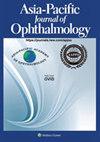反复低强度红光治疗后近视前期儿童脉络膜厚度的变化及其在预测近视预防和控制近视移位中的作用
IF 4.5
3区 医学
Q1 OPHTHALMOLOGY
引用次数: 0
摘要
目的:探讨反复低水平红灯(RLRL)治疗1年后,准近视儿童脉络膜厚度(ChT)的纵向变化及其对近视预防和近视转移效果的预测价值。方法:278例近视前期患者(-0.50 D <球面等效屈光度,SER≤0.50 D)随机均匀分为RLRL组和对照组。在入组前及干预后每3个月测量一次OCT、视力、AL、SER等参数。对被试者双眼的数据进行分析。结果:共分析463只眼。由于COVID-19大流行,RLRL组的176名参与者的治疗中断。继续RLRL组、中断RLRL组和对照组的基线特征平衡良好。在RLRL持续组和中断组,平均ChT在3个月时显著增加(均P < 0.001),中央凹下ChT明显增厚。包括性别和3个月ChT变化的模型预测12个月时满意的近视预防的曲线下面积(AUC)为0.983。同时使用基线年龄、性别、3个月ChT变化联合指标预测12个月AL进展控制的模型的疗效达到0.944。结论:持续的RLRL干预在近视人群中引起了明显的ChT增厚,特别是在中央凹下区。对于接受RLRL治疗的参与者,3个月的ChT变化结合其他基线因素对近视预防效果具有可接受的预测性区分。本文章由计算机程序翻译,如有差异,请以英文原文为准。
Changes in choroidal thickness in pre-myopic children after repeated low-level red-light therapy and their role in predicting myopia prevention and controlling myopic shift
Purpose
To investigate longitudinal changes in choroidal thickness (ChT) after 1-year treatment of repeated low-level red-light (RLRL) and their predictive value in efficacy on myopia prevention and myopic shift among pre-myopic children.
Methods
278 pre-myopic (-0.50 D < spherical equivalent refraction, SER ≤ 0.50 D) participants were assigned to the RLRL group and control group randomly and evenly. The OCT, visual acuity, AL, SER and other parameters were measured before enrollment and every 3 months after intervention. The data from both eyes of the included participants were analyzed.
Results
A total of 463 eyes were analyzed. Due to the COVID-19 pandemic, 176 participants in the RLRL group had treatment interrupted. The continued RLRL group, interrupted RLRL group and control group were well balanced in baseline characteristics. In the continued and interrupted RLRL group, the average ChT increased significantly at 3-month visit (all P < 0.001) and the subfoveal ChT thickened evidently. The area under the curve (AUC) for the models including gender and 3-month change in ChT to predict satisfactory myopia prevention at 12 months was 0.983. The efficacy of the models that also used the combined indicators of baseline age, gender and the 3-month change in ChT to predict AL progression control over 12 months reached 0.944.
Conclusions
Continued RLRL intervention induced notable thickening of ChT in premyopic population, especially at the subfoveal sector. For participants received RLRL treatment, the 3-month change in ChT combined with other baseline factors have acceptable predictive discrimination of myopia prevention efficacy.
求助全文
通过发布文献求助,成功后即可免费获取论文全文。
去求助
来源期刊

Asia-Pacific Journal of Ophthalmology
OPHTHALMOLOGY-
CiteScore
8.10
自引率
18.20%
发文量
197
审稿时长
6 weeks
期刊介绍:
The Asia-Pacific Journal of Ophthalmology, a bimonthly, peer-reviewed online scientific publication, is an official publication of the Asia-Pacific Academy of Ophthalmology (APAO), a supranational organization which is committed to research, training, learning, publication and knowledge and skill transfers in ophthalmology and visual sciences. The Asia-Pacific Journal of Ophthalmology welcomes review articles on currently hot topics, original, previously unpublished manuscripts describing clinical investigations, clinical observations and clinically relevant laboratory investigations, as well as .perspectives containing personal viewpoints on topics with broad interests. Editorials are published by invitation only. Case reports are generally not considered. The Asia-Pacific Journal of Ophthalmology covers 16 subspecialties and is freely circulated among individual members of the APAO’s member societies, which amounts to a potential readership of over 50,000.
 求助内容:
求助内容: 应助结果提醒方式:
应助结果提醒方式:


